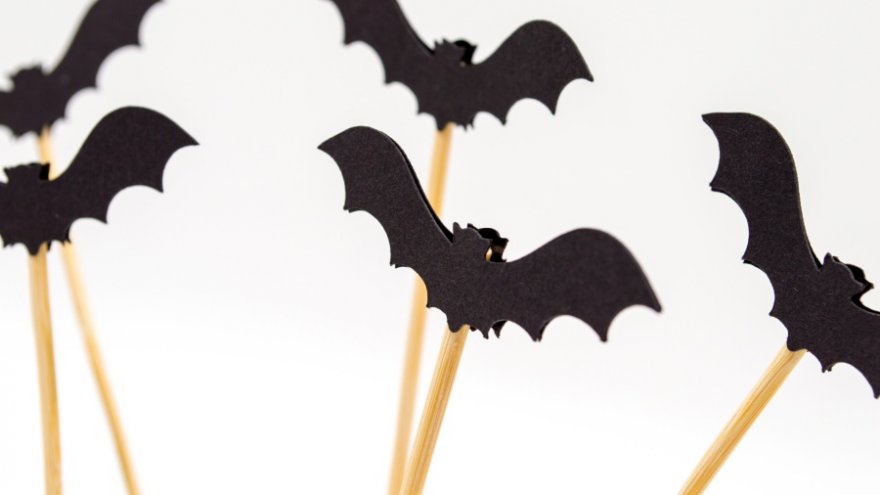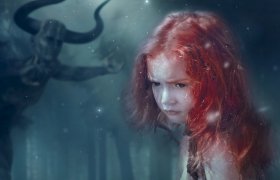The History of Halloween

If I asked you to close your eyes and think of Halloween, what would you picture? I bet a lot of us think of the same things. Halloween celebrations can be as varied as the people who celebrate, but there are a few traditions that seem to be universal. There are all kinds of symbols and traditions that are associated with the holiday, but why? Where and when did this all come together? The history of Halloween is long and twisty, just like a witch’s finger! Get comfortable, because we’re about to go on a journey into the past to find out why Halloween is the way it is.
Samhain
The holiday itself is said to trace back to ancient Celts and their holiday Samhain a festival celebrating the end of the harvest season and the beginning of a new year. It took place on October 31 and was punctuated by bonfires and fortune telling. The whole town would get together and build a large fire, wear costumes and try to tell the future for each other before winter set in. At the end of the evening, everyone would take a bit of the fire home to light their fireplaces to protect them from evil, as they believed that Samhain was the night where the line between life and death was blurred and the dead could come back and haunt the living.
The festival of Pomona
Eventually, the Romans came through and conquered most of the Celtic lands and Samhain and the Roman festival to honor Pomona which took place in the fall. Pomona was a goddess of nuts and fruits, especially fruits like apples, which may explain some of the apple related Halloween traditions like bobbing for apples or caramel apples or even apple cider.
All Hallows Eve
Not too long after this time the pope designated the Parthenon to all Christian Martyrs and another pope moved the holiday of All Saints Day to November first, making the night before “All Hallows Eve” which eventually became known as Halloween.
Celebrations in America
In the early days of America, Halloween was seen as a day for bonfires, socials, ghost stories and eventually a free day for pranks. Young teens would rampage through the streets playing pranks and causing trouble and for the most part they didn’t get in trouble for it too often because that’s what Halloween was for, right?
![]() It wasn’t until the 1950’s that candy makers realized they could capitalize on Halloween as a candy holiday in addition to Valentine’s and Christmas. Trick or treat became mainstream sometime after, occupying the children with candy collection instead of pranks.
It wasn’t until the 1950’s that candy makers realized they could capitalize on Halloween as a candy holiday in addition to Valentine’s and Christmas. Trick or treat became mainstream sometime after, occupying the children with candy collection instead of pranks.
Symbols
Halloween, now a mishmash of many other holidays from many cultures have not only taken on all the varied traditions but also many symbols:
Ghosts
It almost goes without saying that a holiday predicated on the idea that the line between living and dead is nonexistent that ghosts would be around. Many cultures have a day where they honor the dead in the fall, as the fall is often associated with death due to the crops dying or becoming dormant and the nights becoming longer.
Jack-o-lanterns
There is a folklore story about a character called Stingy Jack who was said to have played a successful trick on the devil, only to be punished by roaming the Earth alone with only one ember to light his way, he put the ember into a carved turnip and used it as a makeshift lantern to get around. The Irish and Scottish would carve scary faces into gourds and turnips to scare away evil ghosts and spirits.
 Black cats
Black cats
Black cats are associated with witches, often seen as their familiars or helpers. This is also the root of the idea that black cats are unlucky because seeing one may mean a witch was nearby. Cats themselves are seen in many cultures as being spooky because they are able to travel in the dark with stealth, and their glowing eyes probably don’t help that creep factor much either.
Witches
Witches have been seen throughout many cultures as women who conjure up curses and spells and have made certain deals with the devil. While the autumn season is a time when plants go dormant, many farmers and villagers often saw it fit to blame these crop changes on witches and spells. There were many cases of witch hunts going on, the most famous example might be the Salem witch trials when many women were found guilty of witchcraft, but later it was known that it was all just a lot of gossip and not truly witchcraft.
Vampires
Vampires are a type of revenant or a being that has died and come back to life, like a zombie or a mummy. Unlike a zombie or a mummy though, vampires are anything but mindless. They are often seen as tricky or sneaky, getting close to people without revealing the truth of who they are before it’s too late. Folklore says that a vampire cannot enter your house unless they are invited, so be careful who you let in!
Bats and spiders
When the evil, the spooky, and the just plain weird weren’t enough, people started getting creeped out by the creepy crawlies of the world. Cobwebs bring up the image of a place that is abandoned and empty, and spiders do like to trap their prey. Bats, a nocturnal animal, was often attracted to the bonfires that people lit in celebration because the bonfires themselves attracted flying insects which are a dietary staple of many bats. Bats catch their prey by swooping into the swarm, which can be frightening for bystanders who can see the bat but not the bugs. Many probably felt as if the bats were attacking them directly.
Whatever traditions you choose to participate in this season, it’s good to know where they came from and that Halloween is itself a big melting pot of many celebrations and festivals so feel free to make it your own. Do what you like, and maybe even come up with some traditions of your own.






